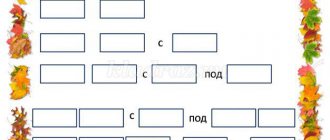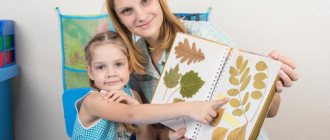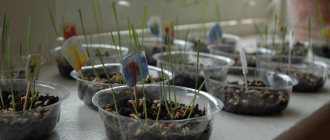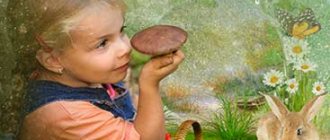Children's drawings and pictures on an environmental theme
The problem of environmental pollution through the eyes of children is expressed in their drawings. Preschoolers and primary school students (grades 1, 2, 3, 4) are asked to depict pictures on the topic of ecology. Children in grade 5 and older make posters and collages about the state of the environment and its protection.
The drawn images are presented at competitions and used to design exhibitions about the ecology of their native land and planet.
The drawings have different names; children often come up with inscriptions and slogans that attract attention on their own:
- “Let's save our native nature!”
- “Let's save the world around us!”
- “Mother Nature is asking for help!”
- "Let's protect the planet!"
- “Nature and us” and so on.
The video presents a selection of drawing options.
to contents ^
Protect the environment
Pictures are drawn with pencils, watercolors, gouache, crayons, depending on the child’s wishes.
Let's save nature together
Protect the planet from garbage
Conservationists are calling for a clean world with their own hands. Environmental education teaches children to pick up trash after themselves, throw it away in specially designated places, and not leave potentially dangerous things (fires, chemicals, non-degradable materials, etc.) in the forest, in clearings, or near water bodies.
Protection and conservation of nature
The photo shows drawings calling for ensuring the safety of the environment and protecting it from human influences.
Young ecologist
Drawings on the theme “Ecology of Nature”
Such creativity will also instill in children a love for their native land. If they were asked to bring drawings on the topic of environmental ecology to a children's institution, we can recommend the following.
In this poster, the author shows how specifically each person can help preserve normal ecology and nature. To do this you need:
- pick up trash after yourself;
- After relaxing by the fire, be sure to put it out;
- don’t waste water;
- save energy;
- take care of your home.
Reducing harmful emissions into the atmosphere will also help preserve the environment. It is not for nothing that in the summer motorists are encouraged to switch to bicycles in order to get to work using this transport.
Parents can go on bike rides with their children, thus also engaging in outdoor sports.
The following drawing on the theme of natural ecology is symbolic. Under a bright rainbow, the child depicted a representative of animals, birds, insects, plants and calls on everyone to preserve our nature.
The following work is intended for schoolchildren. To make it, you will need:
- a sheet of paper or whatman paper;
- a simple pencil;
- eraser;
- paints.
First, on paper with a pencil you need to outline the main elements of the canvas.
If some of them didn’t work out right away, you can erase them with an eraser and do them again. The picture is divided into 2 thematic parts. On the left is beautiful nature, a grazing horse, birds soaring in the blue sky, and on the right are industrial enterprises that produce harmful emissions into the atmosphere and, as a result, dead trees, bushes, and grass.
The following poster on the topic “Take care of nature” shows children that they need to protect the forest from fire.
If your child is asked to draw a picture on such a topic, you can give him the following idea. There is a forest, a river, a rainbow, and animals.
If this drawing on the topic “Ecology of Nature” is intended for middle school students, the next one can be reproduced by children from elementary school and older groups of kindergarten. Show them how to draw tree canopies with conical fora and lush canopy. Children will also be able to draw lilies of the valley and strawberries.
Another work was done using a very interesting technique. To make the same, take:
- a needle;
- colored threads;
- a sheet of white cardboard;
- simple pencil.
First, barely pressing the pencil, you need to draw a rainbow, below - the rays of the rising sun.
In the center of the picture are open palms and the inscription “Take care of nature!” We start from the bottom of the canvas. Help your child thread the yellow thread through the eye of the needle and tie a knot at both ends of the thread. The rays of the sun can be made long or consisting of several stitches. Children will embroider a rainbow using threads of different colors and finish the work using the same technique.
The following paintings are based on comparison and contrast.
On the right is a corner of the globe. Explain to the children that it will remain like this if we all protect nature. On the left you can see what it will be like if you litter, don’t take care to put out the fire behind you, or burn it in the wrong place. Pollution of water bodies will also lead to such sad consequences. A child will understand all this if he draws such a canvas.
Another work develops this idea and shows that people are able to resist air pollution; they need to reduce the amount of exhaust gases and pick up trash after themselves.
The following drawing is also intended to instill in children the right thoughts regarding the environment.
To let the kids know that you can make a lot of interesting things out of waste material, offer them the following ideas.
How to draw a poster on the theme of ecology
A poster on an environmental theme can consist of one or more images. At the same time, inscriptions are added to the picture, attracting attention and containing appealing slogans. You can additionally draw an emblem.
The image makes you think about the relevance of environmental problems in the modern world. For example, as in the example poster presented. Below is how to draw it step by step.
More poster options.
Environmental problems pictures
The topic “Ecological Problems” is currently very relevant. Let's make a list of some of the main environmental problems, and also reveal the reasons for their occurrence and the consequences resulting from the barbaric use of natural resources.
Transportation and industry used by humans consume large amounts of oxygen from the atmosphere. At the same time, the person does not make up for the losses and does not comply with the established standards for the purification of waste before it is released into the atmosphere.
Every year, at least 1250 million tons enter the atmosphere. carbon monoxide, up to 170 million tons. sulfur dioxide, 20 million tons. nitrogen oxides, as well as hydrogen sulfide, carbon disulfide, chlorine compounds, fluorine compounds and many other harmful chemical elements.
Basically, soil pollution occurs under the influence of technogenic intensification of production, which does not purify waste, but pours it into the soil.
Residential buildings and household enterprises. Among the pollutants, household waste, food waste, feces, construction waste, waste from heating systems, and worn-out household items predominate; garbage from public institutions - hospitals, canteens, hotels, shops, etc.
Thermal power engineering. In addition to the formation of a mass of slag when burning coal, thermal power engineering is associated with the release into the atmosphere of soot, unburned particles, and sulfur oxides, which ultimately end up in the soil.
Printable coloring pages
Black and white pictures can be printed and colored.








